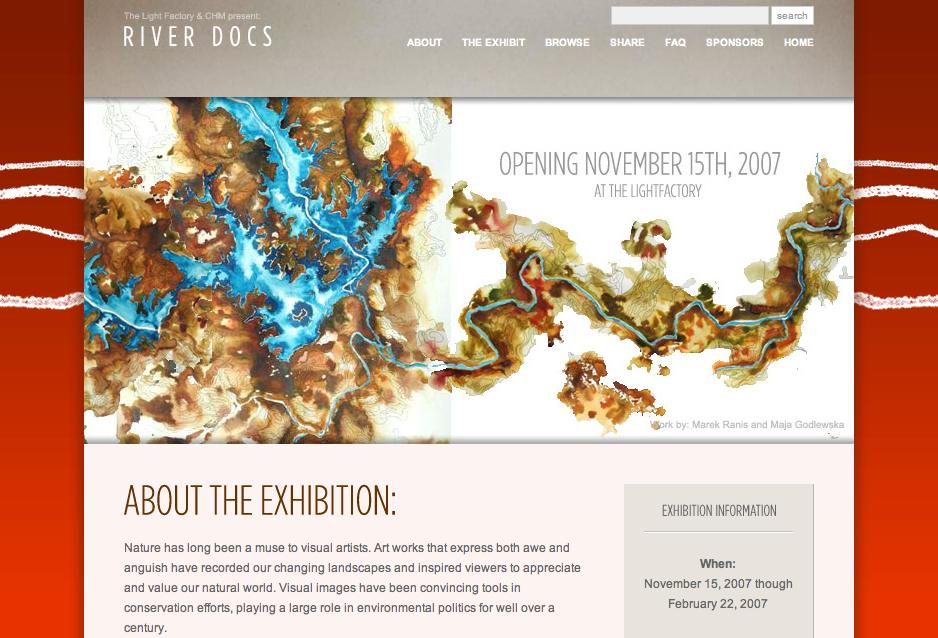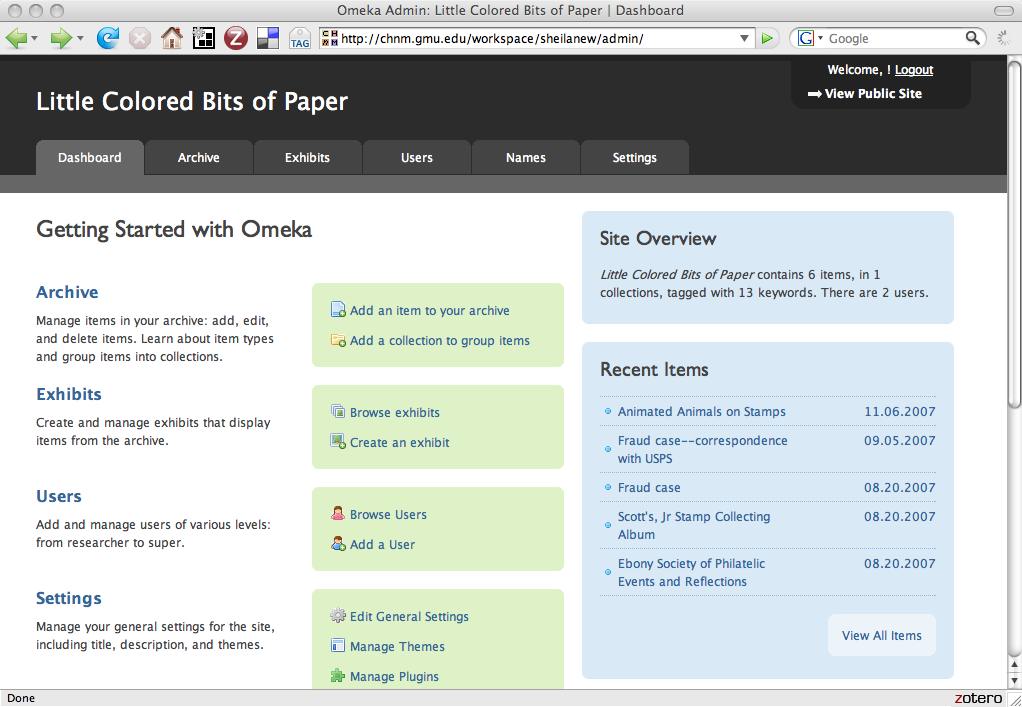 Today the Center for History and New Media launches another major software platform that we hope will be of great help to universities, libraries, museums, historians, researchers, and anyone else who would like to put a collection or exhibit online. It’s called Omeka, from the Swahili word meaning “to display or layout goods or wares; to speak out; to spread out; to unpack.” The public beta released today was underwritten by the generosity of the Alfred P. Sloan Foundation and the Institute of Museum and Library Services.
Today the Center for History and New Media launches another major software platform that we hope will be of great help to universities, libraries, museums, historians, researchers, and anyone else who would like to put a collection or exhibit online. It’s called Omeka, from the Swahili word meaning “to display or layout goods or wares; to speak out; to spread out; to unpack.” The public beta released today was underwritten by the generosity of the Alfred P. Sloan Foundation and the Institute of Museum and Library Services.
I’ll get to the details momentarily, but I’ve found that it’s often helpful to brashly distill years of careful thought, design, and programming into a handy catchphrase that anyone can understand and pass around. For Zotero, it’s “like iTunes for your references and research”; for Omeka, think “WordPress for your exhibits and collections.”
As with Zotero, Omeka grew organically out of a strong need that we identified at CHNM over the last decade, as we built a series of projects that presented, and in some cases collected, historical artifacts. Projects such as the September 11 Digital Archive and associated work with institutions such as the Smithsonian and the Library of Congress made us realize how much work—and how much money—it takes for institutions (and individuals) to mount high-quality and flexible exhibits online, and to manage the underlying collections.
Omeka aims to simplify this entire process, save valuable resources, and create a free and open platform that the museum and library community, and anyone else, can enrich to by developing themes and plugins. The 150 institutions already using Omeka as part of our pre-beta, ranging from the small (North Carolina’s The Light Factory and Cultural & Heritage Museums‘ River Docs exhibit) to the large (the New York Public Library) have already responded to the ease-of-use and power of the platform.

[River Docs exhibit, powered by Omeka]
Not only can Omeka provide a high-gloss front end for an exhibit, but it also provides an equally nice-looking and flexible back end that hews to critical standards (such as Dublin Core). Here’s a sneak peek:

The Omeka start page.

Adding items is a simple process, but collections conform to library and museum metadata standards, and you can also use tags.
The theme-switching process and plugin architecture at the heart of Omeka will be familiar to users who are accustomed to working with popular blogging software, but Omeka includes a number of features that are directed specifically at academic, museum, and library use. First, the system functions using an archive built on a rigorous metadata scheme, allowing it to be interoperable with existing content management systems and all other Omeka installations. Second, Omeka includes a process for building narrative exhibits with flexible layouts.

The layout of your site can be changed with a single click.
These two features alone provide cultural institutions with the power to increase their web presence and to showcase the interpretive expertise of curators, archivists, and historians. But Omeka’s plugin architecture also allows users to do much more to extend their exhibits to include maps, timelines, and folksonomies, and it provides the APIs (application programming interfaces) that open-source developers and designers need to add additional functionality to suit their own institutions’ particular needs. In turn, a public plugins and themes directory will allow these community developers to donate their new tools back to the rest of Omeka users. The Omeka team is eager to build a large and robust community of open-source developers around this suite of technologies.
You can learn much more about Omeka on its website. Credit goes to the fantastic Omeka team: directors Tom Scheinfeldt and Sharon Leon; developer and manager Jeremy Boggs; manager Sheila Brennan; and developers Kris Kelly, Dave Lester, Jim Safley, and Jon Lesser.
Comments
[…] Dan Cohen’s Digital Humanities Blog comes the announcement of the public beta of Omeka, software designed to host digital collections and to show them to their advantage as online […]
Dan, as a Charlotte native, I have to point out that the Light Factory is in North (not South) Carolina.
Geochallenged attributions aside, congratulations to CHNM for another exciting product.
We’re installing an instance of Omeka here in the library which I hope we can tie into MARS (DSpace) to provide a nice front-end to ad-hoc digital object exhibitions (with the actual objects continuing to live in DSpace). We’ll see…
[…] places, including the Official Omeka Blog, Inside Higher Ed, Found History, Steve Lawson, and Dan Cohen’s blog. Tom gives a great overview of the project, and how it fits into our former director Roy […]
Really nice Dan!
A few random gripes, though, looking through the SQL schema:
First, the metadata support is just a series of flat fields. In a relational database? I would have thought the Zotero experience would have shown the practical limitations of this sort of modeling?
Second, this is a familiar issue of mine, but I noticed first/middle/last name columns in one of the tables. I know this is common in (particularly) U.S. based web design, but it’s not very international-friendly.
Third: RSS2? I would have thought a new tool like this would have logically supported Atom as default (and perhaps the RDF RSS flavor).
Good timing! We’re looking to get away from ContentDM this year as we can no longer afford the licensing fees. This looks great!
@Wally: Oops. Thanks for the correction. I think I meant to write Cultural & Heritage Museums of South Carolina. That’s a great idea about using Omeka as an exhibit front end for DSpace. Let the Omeka team know if you need any help.
@Bruce: You should raise these issues on the Omeka forums (though I’ll of course forward them to the Omeka team). The Zotero and Omeka teams are completely distinct, and so there perhaps has not been enough cross-pollination. But these seem like things the Omeka team can address quickly.
@Bruce:
Thanks so much for the comments and points. The Omeka team has been discussing these very things, and we appreciate your input. Let me respond to your points:
1) Experience tells us that individuals and small cultural institutions shy away from collection systems that emphasize esoteric schema. To balance their needs with the needs of advanced users, Omeka offers a generalized, easy-to-use schema that includes a permanent Dublin Core element set (the “flat fields”) that are common to all items, as well as customized item types to which users may assign customized metadata element sets (the “relational” metadata). This way, we feel, the average user will not be overwhelmed by strict metadata standards, while the more advanced users may customize their item types to whatever standards they wish.
2) We agree with you that this is a weakness, and we will be focusing more on localization in the future.
3) We have a ticket on Trac to add an Atom feed. And there is a RDF Dublin Core output that you may not be aware of (using ?output=dc). We intend to add more outputs as time allows.
We welcome any further comments or ideas. Please feel free to post on our forums:
http://omeka.org/forums/
Best,
Jim Safley
Omeka Developer
Center for History and New Media
[…] Dan Cohen did such a great job introducing his readers to Omeka, I will send you to his Feb 20 post to read more. When you’re finished, head over to the […]
[…] specialists in mind, allowing users to focus on content rather than programming. Dan Cohen has a nice blog post with visuals about Omeka. Omeka comes loaded with the following […]
[…] through the installation and customization of Omeka, which Jeremy and Dave work on, and which just launched recently. (And it’s off to a fantastic start, with active forums and nearly 300 downloads in under a […]
[…] Dan Cohen’s Digital Humanities Blog » Blog Archive » Introducing Omeka (tags: chapter2) […]
[…] Dan Cohen, Weblog March 5, 2008 [原文链接] […]
[…] topic (but in the same post just because I like the way the heading sounds!), here’s a first look at Omeka, being billed as “WordPress for exhibits and collections.” Open source and […]
[…] History and New Media at George Mason University- where the software platform was launched) blog entry on the project, viewed a video at code4lib, and attempted to play around in the sandbox a bit. I […]
[…] Director Dan Cohen, says, "Omeka grew organically out of a strong need that we identified at CHNM over the last decade, […]
[…] a task that formerly required either extensive technical skills and/or funding for outside vendors. Described as “WordPress for your exhibitions and collections,” it emphasizes Web 2.0 technologies […]
[…] “Introducing Omeka” (by Dan Cohen) […]
[…] by the steep learning curve if you plan to customize your exhibition at all. Omeka is touted as “WordPress for museums” because of its clean front-end design. And the interface is very intuitive—a few minutes of […]
[…] the Omeka system rivals WordPress’s ease-of-use, leading CHNM Director Dan Cohen to suggest Omeka is “WordPress for your exhibitions and collections.” Omeka also utilizes the same […]